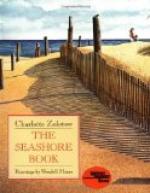Let us begin at the beginning—the egg. Mother Crab carries her eggs with her, under her tail, which itself is always kept tucked up under her body. Out of each egg there comes the queerest little creature! It is just large enough to be seen as it wriggles in the water. Then its skin splits, and there appears a quaint thing with long feathery legs, a big head, a spike on the back of its head, and another spike like a nose.
Who would suspect this strange atom would turn into a Crab! Well, nobody did. It was called a zoea; but you can call it a Crab caterpillar or larva. The maggot is the larva of the fly, and the zoea is the larva of the Crab. With crowds of its brothers and sisters, the zoea kicks about on the surface of the sea. Fishes, and even great whales, swallow these tiny things by the million.
The Crab larva eats and grows. Again and again its skin splits, and a rather different zoea appears. This happens about once a week, until, hey presto! the spiked zoea is now rather like a Crab. The spikes are gone, and now it has tiny claws, and two eyes at the end of stalks. Yet it still owns a tail. At last this is tucked up under its body, and lo! our little friend has changed into a very small Crab. No longer able to swim about, it comes to get a living in the shallow pools of the shore.
Luckily, this helpless baby knows how to hide. He is helped by his colour, for it matches the green and brown of the weeds and rocks. He knows how to dig himself into the sand, and work his shell well down. Then only his funny eyes on stalks peer up at you. At this time of his life he has to “make himself scarce,” and snatch his food when and where he can.
[Illustration: Purse crab.]
We do not eat these little Crabs, but other Crabs do, and so do anemones, gulls, and other hungry creatures; and they themselves hunt sand-hoppers, and eat anything they can find or steal. So they grow bigger; and then, like the boy who grows quickly, the Crab finds his shelly suit a size too small for him!
Now look at his suit. It is a hard coat, a complete suit of armour to protect his soft body. Our picture shows the Lobster, the Crab’s cousin. The Shrimp and Prawn and Lobster are relations of the Crab; these crustaceans, as they are called, are all cased up in a hard crust, which will not stretch the slightest little bit. But the Crab’s body must grow! What is he to do?
At first he starves himself, and so his body shrinks inside its old shell. He loosens himself as well as he can. Soon the shell breaks across, and the Crab struggles to get free. At last he backs out, and leaves his old suit for ever. It is a wonderful performance, for he has withdrawn even from the legs, claws, feelers, bristles, eye-stalks and eyes! The old shell is left quite whole—a perfect Crab, but with no Crab inside it!
Now the Crab, in his new suit, hides away. He knows that he is a soft, flabby creature at this time, and that other animals, even Mrs. Crab, would be glad to meet him—and eat him. While his covering is yet soft he grows quickly. When it is hard, he ventures out again, ready to quarrel and fight.




